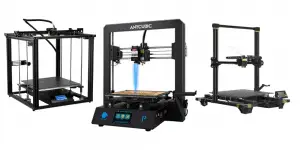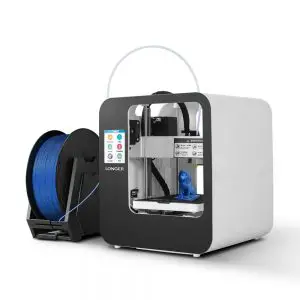One of the things that have often gone through my mind when I’m using a 3D printer is if the fumes are not healthy for me? Oftentimes I ask myself, “should you be worried about breathing in these fumes?”
So I did a little digging and I found that in 2016 a study was conducted that investigated this very topic. The Illinois Institute of Technology essentially two find out the answer to my question and more.
The study concluded that PLA filament is safe to use when 3D printing however it did find that caution should be used when printing with ABS filament. ABS filament should actually only be used in a well-ventilated area.
When it comes down to it you have to be mindful of what types of materials you are actually printing with because not all filament types are as harmful as others.
PLA Filament 3D Printer Fumes
Hands down PLA filament is the safest material that you can use with your 3D printer. One of the main reasons for this is because PLA is a fully biodegradable substance and it is typically made up of vegetable-based plastic materials. Cornstarch, for instance, is often used as a key raw material in its production. This is the primary reason why PLA fumes have a very recognizable sweet smell when it is used in 3D printing.
As with many things these days long-term effects are not always well understood. For that reason, we think that it would be ideal to utilize a high-quality air purifier if you will be using the machine and a small enclosed space.
ABS Filament 3D Printer Fumes
One of the most noticeable things, when you use ABS filament, is that there is often a strong smell of plastic. Without a doubt, you will certainly notice that smell upon entering a room.
You may not be surprised to know that ABS filament actually gives off a toxic chemical when it is heated up. As you may already know and 3D printing this plastic must be heated in order to produce 3D objects. The name of the chemical that is responsible for these toxic fumes is called Styrene. Overexposure to this substance and often lead to drowsiness, headaches, and fatigue. Certainly not something you’ll want to lock yourself in with for a long night of printing. So be cautious when it comes to ABS fumes.
Are 3D Printed Fumes That Bad For You?
When it comes down to it, would you really want to gamble with something like plastic fumes?
I think that it’s safe to say that we all encounter many forms of pollutants in our daily lives. These pollutants come and go as we flow between different environments. For instance, if you’ve ever lived in or visited a busy city you can attest to the fact that there is often a lot of smog from cars passing by. While the smells are not always constant and I do dissipate after a while but this is very different from using a 3D printer in an enclosed area. Often for long periods of time.
Where You Use Your 3D Printer Affect Air Quality
Home Office
Having your own personal space to research, model, slice and print your own 3D printed objects can be a dream come true for many users. If it is an area in which you do most of your 3D printing there are some things that you can do in order to maintain a good level of ventilation.
In a space like this, you can maintain good air quality simply by opening a window, using a fan or an air filter without creating extra noise that you or your family may find distracting.
Bedroom
For many users, the bedroom is the most logical place to place your 3D printer. This is especially true for people who live in small apartments, those with roommates or young adults who don’t have a place of their own quite yet.
When it comes to ventilation this can often be a location that requires the most attention in maintaining high air quality. Typically bedroom will be much smaller than other locations and you may find yourself in the room with the printer while it prints while sleeping, doing homework or surfing the net trying to find your next project to print.
Workshop or Garage
This is probably one of the best places to set up your 3D printer besides a well-ventilated office space if the outside temperature is reasonable. Typically you’ll have access to free-flowing air simply by opening a few windows or lifting up the garage door.
During times where having windows and garage doors up isn’t ideal, you won’t have to worry about fumes bothering anyone or being exposed to them for long periods of time.
Workshops and garages are often out of the way and if you decide to step out the fumes should remain in the space. Often times when you return all of the fumes will be dissipated.
Common Area or Family Room
This is probably not the best place for your 3D printer. Let’s be honest, most times where you have to share space that involves a passion or hobby someone in your family won’t be happy.
Think back to when your parents made you learn to play the violin. I’m sure they were all just ecstatic to hear you play in the family room while they desperately attempt to read their latest novel obsession.
I’m kidding. But if you find yourself in this situation we would strongly recommend ensuring there is proper ventilation in the space. Like other areas in your home, you can achieve this simply by opening a nearby window or using an air purifier.
Air Quality Improvement Solutions for 3D Printing
Besides opening a window or two if space allows there are some other options available for those of you that are looking to keep the air quality good while 3D printing. We wouldn’t suggest leaving a window or garage door open all night while printing so in most cases you will certainly want to use other options for your space. For both your own sake and of course for your family.
No matter where you decide to do most of your printing the temperature of the space will always be a concern. There will be times of the year when opening the window won’t make a lot of sense due to the sensitive nature of some filament types and printers. Why risk the possible fluctuation in temperatures and poor print quality when there are other options? Let’s cover a couple so that you have an idea of what may work best for your space.
Air Purifiers
This is a great method for maintaining good air quality, especially for those who have their 3D printer located in a smaller more enclosed area. You’ll really notice the difference right away. The very first time I used one in my home office I was quite surprised by the results.
Printing with filaments that leave behind a strong plastic odor such as ABS air purifiers do a great job of removing all traces both during and after printing.
When it comes to the type of air purifiers that work best we recommend those that use HEPA and carbon filter which will eliminate odors. Let’s briefly talk about why.
What’s important about HEPA filtration and charcoal carbon filters?
It’s simple. HEPA stands for High-Efficiency Particulate Air and it is the staple of filters that are able to trap at least 99.97% of particles that are 0.3 microns. This is important because these filters will be able to trap the small harmful particles that are produced from the fumes your 3D printer emits.
What’s important about Charcoal carbon filters?
This is also pretty straight forward. Basically air purifiers are able to use charcoal or carbon filters in order to filter and absorb odors, smoke, fumes and other compounds from the air.
3D Printer Enclosures
This is a great option but not one that is widely available. It is however probably one of the most efficient ways to rid your workspace from harmful fumes. With it being more of a new invention, it’s a bit more challenging to find.
Users can decide to create or build their very own enclosure system however this would certainly require a bit more skill and effort than it may be worth. Keeping an eye out for future 3D printers that come standard with this capability is probably more ideal.
Verdict
Hopefully, this article has been able to shed a bit more light on whether or not breathing in fumes from your trusted 3D printer is safe. While there are always concerns with any hobby we would hate for you to take this topic to heart. Overall, this isn’t something you really need to stress over.
While you should always exercise caution when operating any machine there are always going to be things you can do to provide a safer experience. Using the tips outlined here in this article you’ll be well on your way to creating the best atmosphere to print.
With that being said if you’d like to exercise a little caution we certainly recommend an air purifier.






